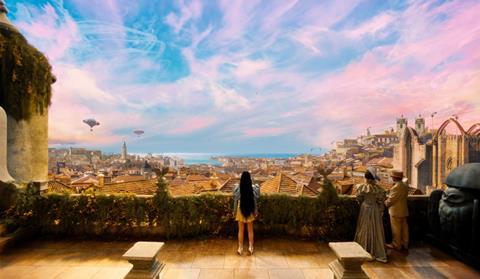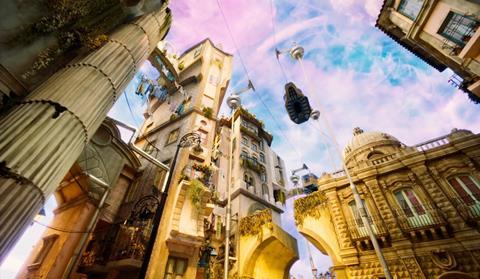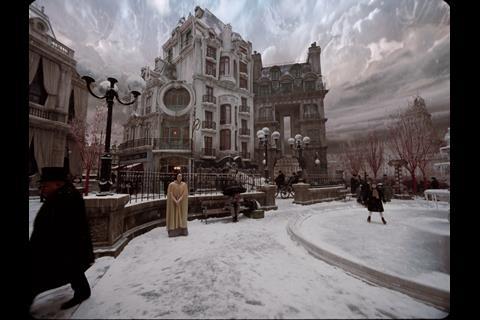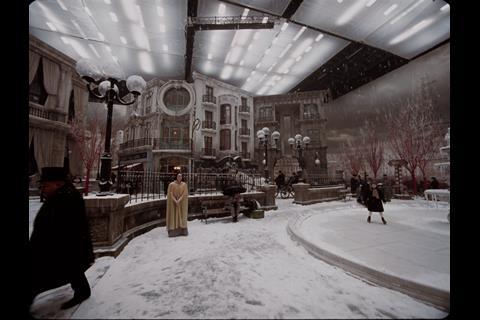VFX house assisted with virtual production as well as VFX shots and environments

Union has revealed its BAFTA-nominated work on feature film Poor Things.
Directed by Yorgos Lanthimos through Element Pictures for Searchlight Pictures, and starring Emma Stone, Mark Ruffalo, Willem Dafoe and Ramy Youssef, Poor Things is written by Tony McNamara and based on the 1992 novel of the same name by Alasdair Gray. The plot focuses on Bella Baxter, a young Victorian woman brought back to life by the unorthodox Dr. Godwin Baxter. Hungry for the world, Bella runs off on cross continent adventures with debauched lawyer Duncan Wedderburn, and in time grows steadfast in her stand for equality and liberation.
Union, led by creative director, Simon Hughes and VFX producer Tallulah Baker, worked with production designers James Price and Shona Heath, and cinematographer Robbie Ryan, from the earliest stages of pre-production.
Hughes said, “VFX are integral to the story throughout and the work and has pushed creativity in filmmaking, raising the bar in every way, particularly in terms of surrealism, beautifully creating the bizarre, eerie and sometimes ludicrous. This really was an incredible film to be involved in and we are blown away by the result.
“It’s a testament to the unrelenting hard work of the whole Union crew and of course, the genius of Yorgos.”
The film begins in a the film begins in a largely self-contained mansion set before moving onto visit London, Paris, Lisbon and Alexandria. This was shot on film, using a combination of both colour and black and white with periodic use of fisheye lenses, which added layers of complexity and challenges for VFX - particularly when creating and extending the environments.
Virtual production played a large part in the production, with Union’s VFX onset supervisor Tim Barter onsite in Budapest, where 11 70m x 90m wrap-around LED screens were employed to project some of the film’s fantastical environments. These ‘inky’ sky and ocean environments were created referencing the work of artist Chris Parks. The team created CG ocean simulations and renders designed to work as 50-second clips at 24K, 11 accompanying DMP skies with added cloud movement and additional stylistic moving atmospheric effects.
The decision to use miniatures was deliberate in terms of the look of the film and the VFX environments had to be sensitive to this. Ensuring the scale of the CG water worked in relation to the scale of the miniature was particularly challenging - especially when combined with live action shot on set.
The Alexandria environment involved vast establishing shots that pull out as wide as possible. The Union team used lidar scans of the miniatures as a starting point for this fully CG environment that includes CG water, sky and palm trees as well as a fully CG boat, a CG cable car and a lot of FX simulation to enhance the atmosphere, including dust and chimney smoke.
The London environment was shot with an 8mm lens so was particularly stylised. The movement in the sky had to reflect the ocean with water displacement and undulation. Tower Bridge was created as a miniature and the London rooftops referenced 1950s filmmaking so various period signs of life were added including chimney smoke elements and fireworks to match the look of the film. This environment also required the creation of CG Zeppelins.
The Paris environment was shot as part of the studio build in Budapest then enhanced in VFX with the addition of a more surreal CG sky and associated elements.
The Lisbon environment was also shot on an 8mm lens. The set was extended in CG, again with very stylised skies and the film’s signature surreal look. Alfie’s mansion was also a miniature within a beautiful fully CG environment that required a huge amount of garden detail covering a multitude of shrubs and greenery to create the impressive, gritty outside space.
Another less than ordinary element of the Poor Things world is the hybrid animals, created by the doctor’s experimentation. These quirky creatures are present throughout the film, wandering around the grounds like barnyard creatures, reflecting the 1920s look of the film, movement and cinematography.

There are seven different hybrids in the final film but the VFX process involved the creation of many more until the final seven were selected.
Lanthimos was keen to try and find as much of an in camera and 2D solution based approach as possible to embrace the random physical nuances of animal movements that are inherently difficult to capture in CG.
Union’s solution was to over shoot and come back with multiple takes and multiple animals then test different combinations to see which animals and moments worked well when combined together.
Hughes explained, “It started with a series of test shoots with an animal trainer which narrowed down the selection prior to the second unit shoot, as some animals just didn’t want to behave at all. When it came to combining them some proved more difficult than others due to a combination of their independent movements, the camera moves and distorted lenses.
“There was a significant degree of rebuild and some CG was used to help with the joins. 3D scans of the animals were used to help us align the different elements and create the textures and scaring where they join together. The scar designs were based on paint over concepts to preserve the naturalistic movement of the real animals while still creating a more fantastical layer of ‘strangeness’ in keeping with the film’s tone.”
There’s also a Frankenstein moment in the film when Bella Baxter is brought back to life by the doctor. This involved a large amount of power, electricity, lightning treatments and sparks. These were complex and involved a lengthy process to ensure they were sympathetic with the look of the film.









No comments yet